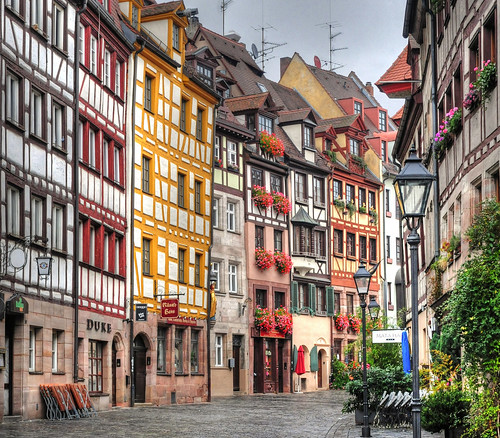The southern part of the old town, known as Lorenzer Seite, is separated from the north by the river Pegnitz and encircled to the south by the city walls.
Nuremberg Castle: the three castles that tower over the city including central burgraves' castle, with Free Reich's buildings to the east, the Imperial castle to the west.
Heilig-Geist-Spital. In the centre of the city, on the bank of the river Pegnitz, stands the Hospital of the Holy Spirit. Founded in 1332, this is one of the largest hospitals of the Middle Ages. Lepers were kept here at some distance from the other patients. It now houses elderly persons and a restaurant.
Hauptmarkt, which provides a picturesque setting and famous market for gingerbread. Nuremberg's star attraction is the Gothic Schöner Brunnen (Beautiful Fountain) which was erected around 1385 but subsequently replaced with a replica (the original fountain is kept in the Germanisches Nationalmuseum). The unchanged Renaissance bridge Fleischbrücke crosses the Pegnitz nearby.
The following churches are located inside the city walls: St. Sebaldus Church, St. Lorenz, Frauenkirche (Our Lady's Church), Saint Klara, Saint Martha, Saint Jakob, Saint Egidien, and Saint Elisabeth.
Gothic St Lorenz-Kirche (St. Lorenz church, St. Lorenz), one of the most important buildings in Nuremberg. The main body was built around 1270-1350.
The church of the former Katharinenkloster is preserved as a ruin, the charterhouse (Kartause) is integrated into the building of the Germanisches Nationalmuseum and the choir of the former Franziskanerkirche is part of a modern building.
The Walburga Chapel and the Romanesque Doppelkapelle (Chapel with two floors) are part of Nuremberg Castle.
The Johannisfriedhof is a medieval cemetery, containing many old graves (Albrecht Dürer, Willibald Pirckheimer, and others). The Rochusfriedhof or the Wöhrder Kirchhof are near the Old Town.
The Tiergarten Nürnberg is a zoo stretching over more than 60 ha in the Nürnberger Reichswald. It is the home of Flocke, an orphan polar bear cub who in 2008 became a major attraction and a figure of a large publicity campaign for Nuremberg's metropolitan region.
There is also a medieval market just inside the city walls, selling handcrafted goods.
The German National Railways Museum (German) (an Anchor Point of ERIH, The European Route of Industrial Heritage) is located in Nuremberg.
The Nuremberg Ring (now welded within an iron fence) is said to bring good luck to those that touch it.
The Nazi party rally grounds with the documentation-centre.
Nuremberg Castle: the three castles that tower over the city including central burgraves' castle, with Free Reich's buildings to the east, the Imperial castle to the west.
Heilig-Geist-Spital. In the centre of the city, on the bank of the river Pegnitz, stands the Hospital of the Holy Spirit. Founded in 1332, this is one of the largest hospitals of the Middle Ages. Lepers were kept here at some distance from the other patients. It now houses elderly persons and a restaurant.
Hauptmarkt, which provides a picturesque setting and famous market for gingerbread. Nuremberg's star attraction is the Gothic Schöner Brunnen (Beautiful Fountain) which was erected around 1385 but subsequently replaced with a replica (the original fountain is kept in the Germanisches Nationalmuseum). The unchanged Renaissance bridge Fleischbrücke crosses the Pegnitz nearby.
The following churches are located inside the city walls: St. Sebaldus Church, St. Lorenz, Frauenkirche (Our Lady's Church), Saint Klara, Saint Martha, Saint Jakob, Saint Egidien, and Saint Elisabeth.
Gothic St Lorenz-Kirche (St. Lorenz church, St. Lorenz), one of the most important buildings in Nuremberg. The main body was built around 1270-1350.
The church of the former Katharinenkloster is preserved as a ruin, the charterhouse (Kartause) is integrated into the building of the Germanisches Nationalmuseum and the choir of the former Franziskanerkirche is part of a modern building.
The Walburga Chapel and the Romanesque Doppelkapelle (Chapel with two floors) are part of Nuremberg Castle.
The Johannisfriedhof is a medieval cemetery, containing many old graves (Albrecht Dürer, Willibald Pirckheimer, and others). The Rochusfriedhof or the Wöhrder Kirchhof are near the Old Town.
The Tiergarten Nürnberg is a zoo stretching over more than 60 ha in the Nürnberger Reichswald. It is the home of Flocke, an orphan polar bear cub who in 2008 became a major attraction and a figure of a large publicity campaign for Nuremberg's metropolitan region.
There is also a medieval market just inside the city walls, selling handcrafted goods.
The German National Railways Museum (German) (an Anchor Point of ERIH, The European Route of Industrial Heritage) is located in Nuremberg.
The Nuremberg Ring (now welded within an iron fence) is said to bring good luck to those that touch it.
The Nazi party rally grounds with the documentation-centre.
"A journey of a thousand miles must begin with a single step." -- Lao Tzu
Copyright © Demetrios the Traveler


No comments:
Post a Comment